6 Steps To Create An Effective Ideal Customer Profile
An effective ideal customer profile (ICP) is the foundation of the customer acquisition process. But how do you go about creating one? Creating an effective ICP requires taking the time to understand who you are targeting and what they need. It would be great if you had all the steps defined to build one. But if you are looking for them, you are at the right place!
In this post, we’ll show you how to build an ideal customer profile in 6 simple steps. But before that, we’ll brush up on the basics and look at a few examples.
Table of Contents
What Is An Ideal Customer Profile?
An ideal customer profile is an important concept that helps businesses understand the needs and preferences of their target market. It is a detailed description of the characteristics of a customer segment that has a greater likelihood of making purchases.
A customer profile typically includes demographic information such as
- Age
- Gender
- Location
- Job title
- Income level
It may also include psychographic information such as lifestyle, interests, values, and opinions.
By understanding the needs and preferences of an ideal customer profile, businesses can create more effective marketing campaigns, tailor product offerings, and provide better customer service. Ultimately, an ideal customer profile helps businesses maximize their profits by identifying the most profitable segments of their target market.
Why Create An Ideal Customer Profile?
Creating a customer profile for your business is essential because you can…
1. Target the ones who are most likely to use your product or service

By understanding your customer, you can tailor your marketing message better and target the people most likely to use your product or service. An ideal customer profile can help create highly targeted campaigns focusing on the customers most likely to respond positively to your product or service. With an ICP, you can also create more compelling customer segmentation strategies, helping you to refine your message further and maximize the reach of your campaigns. In short, creating an ideal customer profile helps you target the right people—the ones who are most likely to use your product or service.
2. Speed up conversions
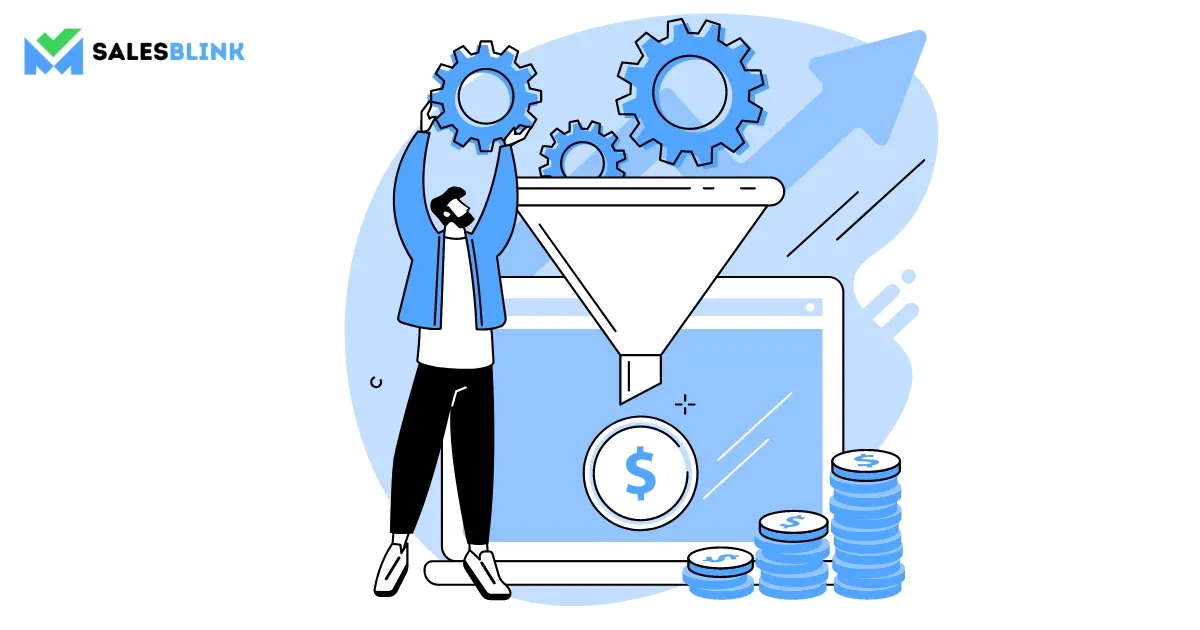
Creating an ICP is a great way to help speed up conversions for any business. You can design your website, marketing materials, and sales process to cater to the ideal customer profile created. This will help you attract the right customers and increase their conversion chances. Additionally, by focusing on your ICP, you can streamline the sales process and make it easier for potential customers to understand your business.
3. Align development, marketing & sales teams
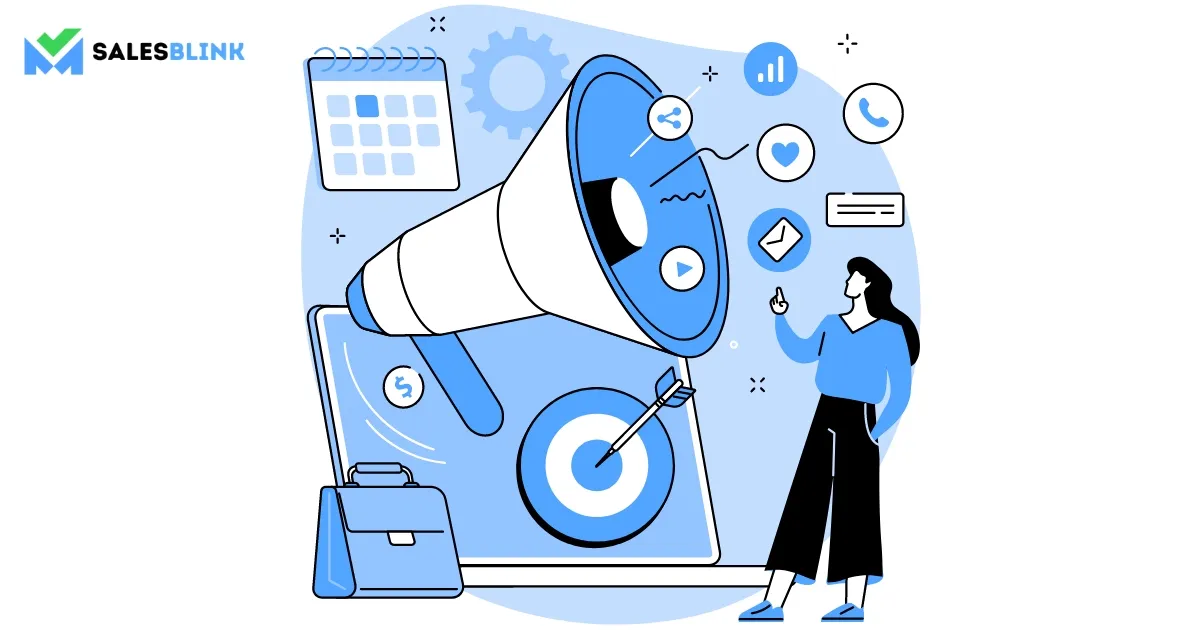
Creating an ICP is essential in aligning development, marketing, and sales teams. By developing a detailed profile of an ideal customer, you can ensure that all the teams are working towards the same goal and that the product or service you offer meets the needs of your target customers. For example, with an ICP in hand, the development team can create a product or service that meets the customer’s needs, while the marketing team can craft messages and campaigns tailored to the customer’s interests. Finally, the sales team can use the customer profile to prioritize leads and focus their efforts on those customers who are most likely to purchase. This way, you can ensure that everyone is on the same page.
4. Increase brand loyalty & referrals

The right ICP can get you clients in B2B, but it is your job to make the journey great for them. They will turn into patrons if you leave no stone unturned in giving them a world-class experience with your product or service. Once that happens, you will notice that they refer your brand to others in their circle. So, one right step can lead to a lot of positive outcomes for your business.
What’s The Difference Between An Ideal Customer Profile And A Buyer Persona?
An ideal customer profile is a general description of the type of customer most likely to purchase your product or service. It includes demographic information such as age, gender, geographic location, and income. It also includes psychographic information, such as interests, values, and lifestyle. An ICP can help you understand your target market and the path to reach them.
A buyer persona is a more specific and detailed description of your ideal customer. It includes all the information in an ideal customer profile but goes into greater depth. A buyer persona contains pain points, goals, and buying behaviors. It also includes understanding how customers interact with your brand, from their initial awareness to their purchase decision. Buyer personas help you better understand the motivations behind your customer’s behavior and provide insights into how to serve them best.
While an ideal customer profile can help you to identify a customer base, a buyer persona can help you to improve the customer experience and increase sales. To create an effective campaign, you should use an ICP and a buyer persona. By understanding customer characteristics and behaviors, you can create targeted messages more likely to resonate with your target audience.
Example of an Ideal Customer Profile
Here are ideal customer profile examples to help you get a better idea.
1. The Five Abilities
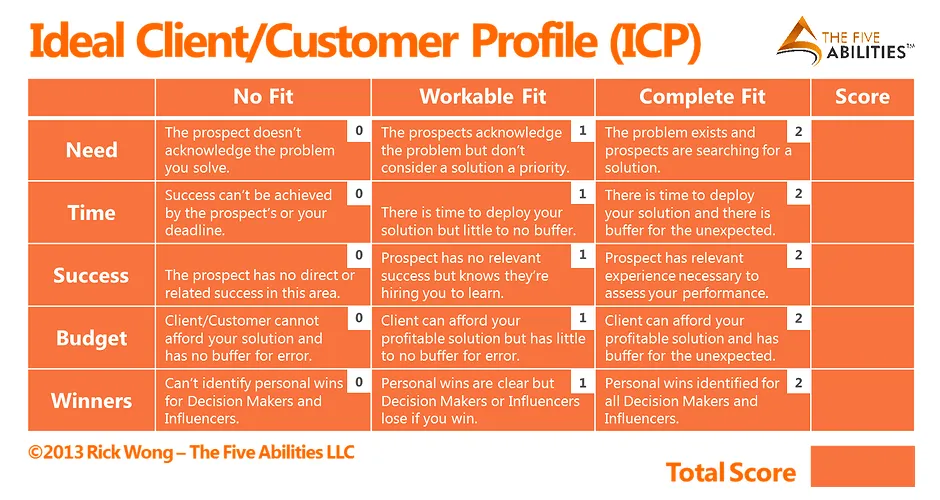
The above can help reps find out when a client is a good fit. It is possible to score prospects based on different factors. Also, reps can determine who is more likely to convert with the right nurturing. This also helps set priorities while choosing which client to work on.
2. ICP with interests
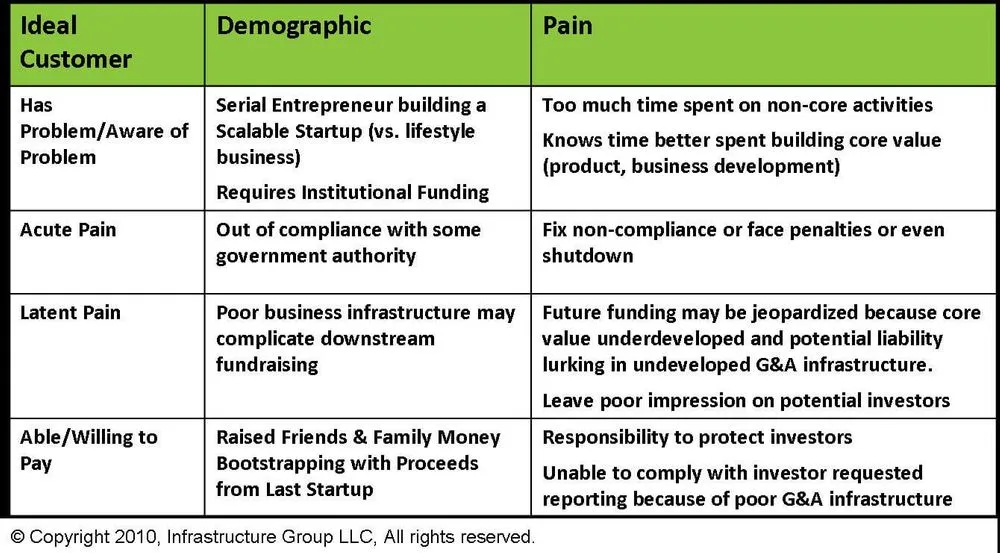
The above ICP considers the customer’s interests and includes demographics and psychographics. The pain point faced by ideal customers is clear and will make the lives of any sales rep easier.
So, these were the examples of ideal customer profile. You would now know how to create a customer profile. Let’s move ahead now.
Steps To Create An Ideal Customer Profile
Here are the steps required to create an ICP.
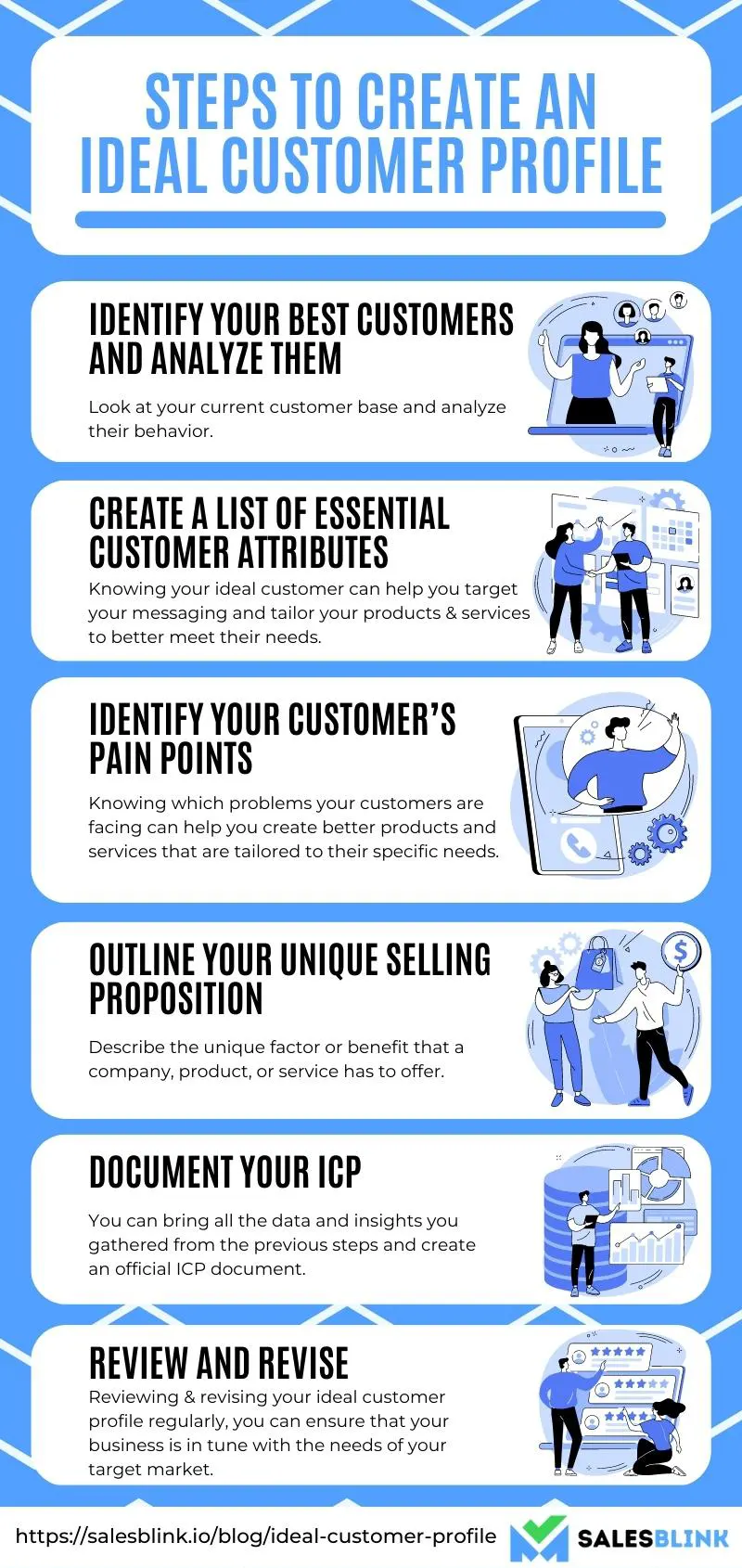
1. Identify your best customers and analyze them
To create an ICP, you need to identify your best customers. Start by looking at your current customer base and analyzing their behavior. Track what products they buy, how often they purchase, and how much they spend. Then, look at other factors such as demographic information, interests, and location. Once you’ve gathered all of this data, you can create an ideal customer profile that reflects the characteristics of your best customers. You can then use this profile to target potential new customers who share the same characteristics as your best customers. From here, you can use this profile to target similar customers through marketing campaigns, tailor products to fit their needs and ensure you channel your efforts in the right areas. You can complete the first step to creating an ICP with the right data and analysis.
2. Create a list of essential customer attributes
Creating an ICP is important in any successful marketing strategy. Knowing your ideal customer can help you target your messaging and tailor your products and services to meet their needs better. With such campaigns, businesses can focus on specific customer segments and customize their messaging to convert leads into paying customers more effectively. Here is a list of essential customer attributes to consider when creating your ideal customer profile:
- Demographics (age, gender, location)
- Occupation
- Industry
- Income level
- Technology usage
- Pain points and needs
- Psychographics
3. Identify your customer’s pain points
Identifying your customer’s pain points is important. The development of an ideal target customer profile begins with an understanding of customer pain points. Knowing which problems your customers are facing and their needs can help you create better products and services tailored to their specific needs. It can also help you target the right people with your campaigns, ensuring that you reach those most likely interested in what you have to offer. Additionally, by understanding your customer’s pain points, you can better understand their frustrations and come up with solutions.
Examples of common customer pain points include difficulty finding the right product or service, lack of support and customer service, incorrect or incomplete product information, and unrealistic expectations. Knowing the specifics of each pain point can help a company craft an ideal customer profile that aligns with a customer’s particular needs and wants. In addition, a clear understanding of the customer’s desired outcome and how the company can provide a solution to that problem can help to refine the ICP.
If you find yourself feeling low at this stage, you can read sales motivational quotes.
4. Outline your unique selling proposition
In your ICP, you must outline your USP. A unique selling proposition (USP) is a term used to describe the unique factor or benefit that a company, product, or service has to offer. It is the element that sets it apart from the competition and makes it more appealing to potential customers. It should be specific, targeted, and clear so potential customers can quickly understand what makes the company or product different.
A USP will keep development, marketing, and sales teams on the same page.
5. Document your ICP
You can bring all the data and insights you gathered from the previous steps and create an official ICP document. It must contain everything in detail so you don’t have to go elsewhere. Documenting your ICP is essential for any business, as it helps you target and develop strategies tailored to the needs of your target audience. In addition, it helps ensure that resource usage is efficient and effective.
6. Review and revise
When running a successful business, having a clear picture of your ideal customer is essential. But that can be dynamic. That’s why it’s important to review and revise your ICP periodically. Doing so can help you stay ahead of changes in the market and ensure that your customer acquisition and retention strategies are on track. When reviewing your customer profile, consider all the factors, such as whether your target demographic has changed, if there are new product categories or services to add, or if there are any new technologies you could use to reach them. Adjust any pricing to ensure that it is competitive for your target market.
Additionally, consider any potential lifestyle changes that could affect your target markets, such as the rise of telecommuting or other lifestyle changes. Needless to say, by reviewing and revising your ICP regularly, you can ensure that your business is always in tune with the needs of your target market.
Get Ready To Create An Ideal Customer Profile Easily!
As you just saw, creating a compelling ideal customer profile is essential for targeting and engaging the right people with your marketing efforts. By taking the time to research and understand your customer base, you can create a customer profile that will help you get better results. It will set the foundation for successful customer acquisition. Hopefully, by following the steps outlined in this blog post, you’ll be able to create your ICP faster. Do let us know if our inputs have helped you define your ICP!
FAQs
An ideal customer profile is an in-depth description of the characteristics of the customers who are most likely to buy your product or service. It includes details like demographics (age, gender, income level, etc.), location, interests, & buying patterns.
To create an ideal customer profile effectively, you must follow a few steps: identify the best customers, list essential attributes, identify pain points, outline your USP, document your ICP, and review & revise it periodically.
An ICP helps you better understand who your target customers are & what they want from your product or service. Having an ICP allows you to create more effective marketing campaigns, design better products & services, & develop more efficient processes.







